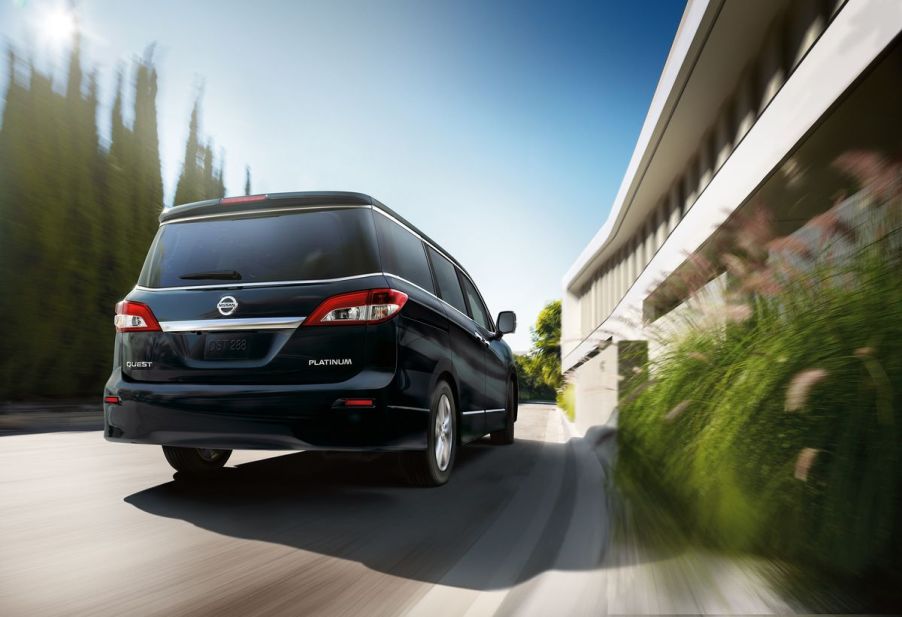
There Are a Shocking Number of Vans in Nissan’s Graveyard
There’s a joke among car enthusiasts that Nissan’s NV nameplate is short for “not viable.” While cruel, the proof is in the pudding. Nissan pulled its big cargo/work van—and its elusive 12-passenger variant—off the market in 2021, along with the smaller city-friendly NV200. Nissan’s Quest minivan also waved the white flag in 2017 after years of struggling with lukewarm sales.
That’s not to say these were bad vehicles. But nor were they spectacular enough to compete with other brands that had already carved out a niche in van land.
Every version of the Nissan NV failed
On paper, the Nissan NV looked quite promising. There was a large sprinter-like version for the trades, a passenger variant packing a dozen seats, and a smaller NV200 cargo van that Nissan advertised as “great for tight corners and tight budgets alike.”
Truth be told, the NV was kinda goofy looking with a long hood that mimicked a pickup truck more than a van, which made sense since the NV shared a platform with Nissan’s Titan pickup truck. Under that hood was a pleasant surprise, though: an available 375 horsepower V8 engine on heavy-duty models, something the competition couldn’t touch.
Unfortunately, not housing the engine in a traditional van “doghouse” that protruded into the front seats meant that the NV’s cabin started that much further toward the rear of the truck, which reduced cargo space. Nissan flogged the NV on the market for a good 10 years between 2011 and 2021, but could never gain any traction against the more established nameplates like the Ford Transit and Ram ProMaster.
Nissan’s smaller van, the NV200, had similar struggles capturing sales in the United States, but Nissan had a plan to remedy that. It would sell customized NV200s as taxi cabs to New York City drivers. Then-mayor Michael Bloomberg dubbed the NV200 as the “taxi of tomorrow.”
Since most cab drivers would be required to purchase one, sales were expected to reach 10,000 to 12,000 units, or approximately 80% of New York City’s taxi fleet over the course of the 10 year deal, according to the New York Times.
After just seven years and a high-profile lawsuit resisting the mandate, a mere 2,671 NV200 taxis made it to the street. In 2018, the spell was broken and drivers were free to purchase vehicles of their choosing. Some NV200 taxi drivers liked the van, while others complained to the New York Times about “bumpy rides, frequent mechanical problems, gas-guzzling engines and the vehicle’s small interior.”
Nissan’s minivan never took off
Badge-engineered vehicles are typically never a great idea, but that’s the strategy that Nissan pursued for its foray into the minivan market. Co-developed with Ford, the first-generation Nissan Quest had a near twin in the Mercury Villager, both of which debuted in 1992 for the 1993 model year.
The Quest/Villager was redesigned for the 1999 model year with some meaningful improvements like a more powerful engine and sliding door on the drivers side in addition to the one on the passenger side. Still, the Quest was deemed pretty mediocre. In a test versus four other minivans, Car and Driver rated the Quest near the bottom of the list, if not dead last.
For the third and fourth-generation Quest minivans, Nissan divorced itself from Ford to develop its own unique vehicle. The newer Quests weren’t necessarily bad, but sales were still quite weak. Minivans’ popularity, in general, was decimated by the cooler-looking but similarly functional Sport Utility Vehicle. The diminished minivan sales that remained were monopolized by models like the Honda Odyssey and Toyota Sienna.
Will Nissan ever make another van?
Interestingly, Nissan does market a minivan for the Japanese domestic market called the Elgrand, which buyers seem to love. So much so that van fans worldwide—including the United Kingdom, Canada, and Australia—are snapping up grey market Elgrands from specialty importers.
Ironically, the alternative minivans that Nissan intended for sale in those markets did not perform well. What’s so special about the Elgrand? Reportedly, the fact that it’s spacious enough to seat seven or eight passengers comfortably, which is something that we take for granted from a minivan on U.S. shores.
Recently, Nissan also shocked the automotive world with a highly futuristic all-electric van concept called the Hyper Tourer. Besides its radical bodywork, which reminds us of a rose gold-hued Cybertruck, the Hyper Tourer emphasizes omotenashi, which means Japanese hospitality.
When the vehicle is placed in autonomous driving mode, the front seats rotate 180 degrees so the passengers up front can interect with those seated in back, like a rolling living room. Nissan also says that the high-tech van senses the driver’s mood using biometrics, then plays appropriate music and adjusts the interior lighting to suit.
Wild concept cars aside, Nissan has probably learned its lesson and will continue to focus on its successful line of SUVs, leaving vans to the companies that already have a strong foothold in the market.



